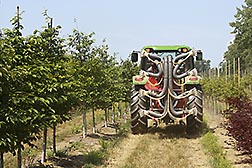New Sprayer Technology Reduces Pesticide Use
By Sharon Durham
February 11, 2016
An experimental variable-rate spraying system that helps growers efficiently apply chemicals to trees was developed by Agricultural Research Service (ARS) scientists at the agency's Application Technology Research Unit in Wooster, Ohio. The new sprayer reduced average pesticide use between 46 and 68 percent, with an average cost savings of $230 per acre for ornamental nurseries. The cost savings can be much higher for orchards and other fruit crop productions.
ARS agricultural engineer Heping Zhu, along with engineer Richard Derksen and research leader Charles Krause, developed the laser-guided sprayer that synchronizes spray outputs to tree structures. Their colleagues at the Ohio State University, Oregon State University and the University of Tennessee evaluated the sprayer, which would help nursery, orchard and grape growers apply chemicals to trees. Zhu and his colleagues received a National Institute of Food and Agriculture (NIFA) grant to develop this technology to control insects and diseases. The technology and performance evaluations were described in several papers in the journal Transactions of the ASABE.
The sprayer developed by Zhu and his colleagues controls output to match targeted tree structures. The two-ton sprayer can treat either a single row, or two to six rows of trees at a time. Conventional spray application technology requires excessive pesticide use to achieve effective pest control in floral, nursery, orchard, and other specialty crop productions, according to Zhu. This challenge is now overcome by the new precision sprayer, which is able to characterize the presence, size, shape and foliage density of target trees and automatically applies the optimum amount of pesticide.
Zhu and his colleagues conducted field trials on the technology's performance in six commercial nurseries in Ohio, Oregon and Tennessee. Their field experiments showed that the precision sprayer consistently applied the correct amount of chemicals despite changes in tree structure and species, and increased consistency of spray deposition uniformity on targets at different growth stages. Pest control with the new sprayer was comparable to that of conventional sprayers and reduced pesticide use.
ARS is the USDA's chief intramural scientific research agency.
Read more about this technology in the February issue of AgResearch magazine.

